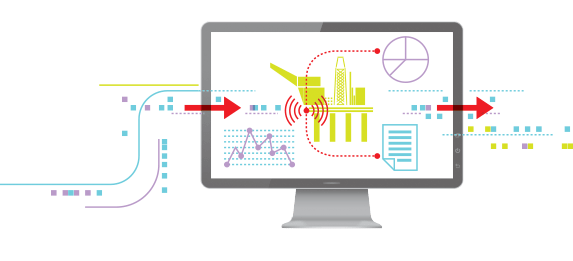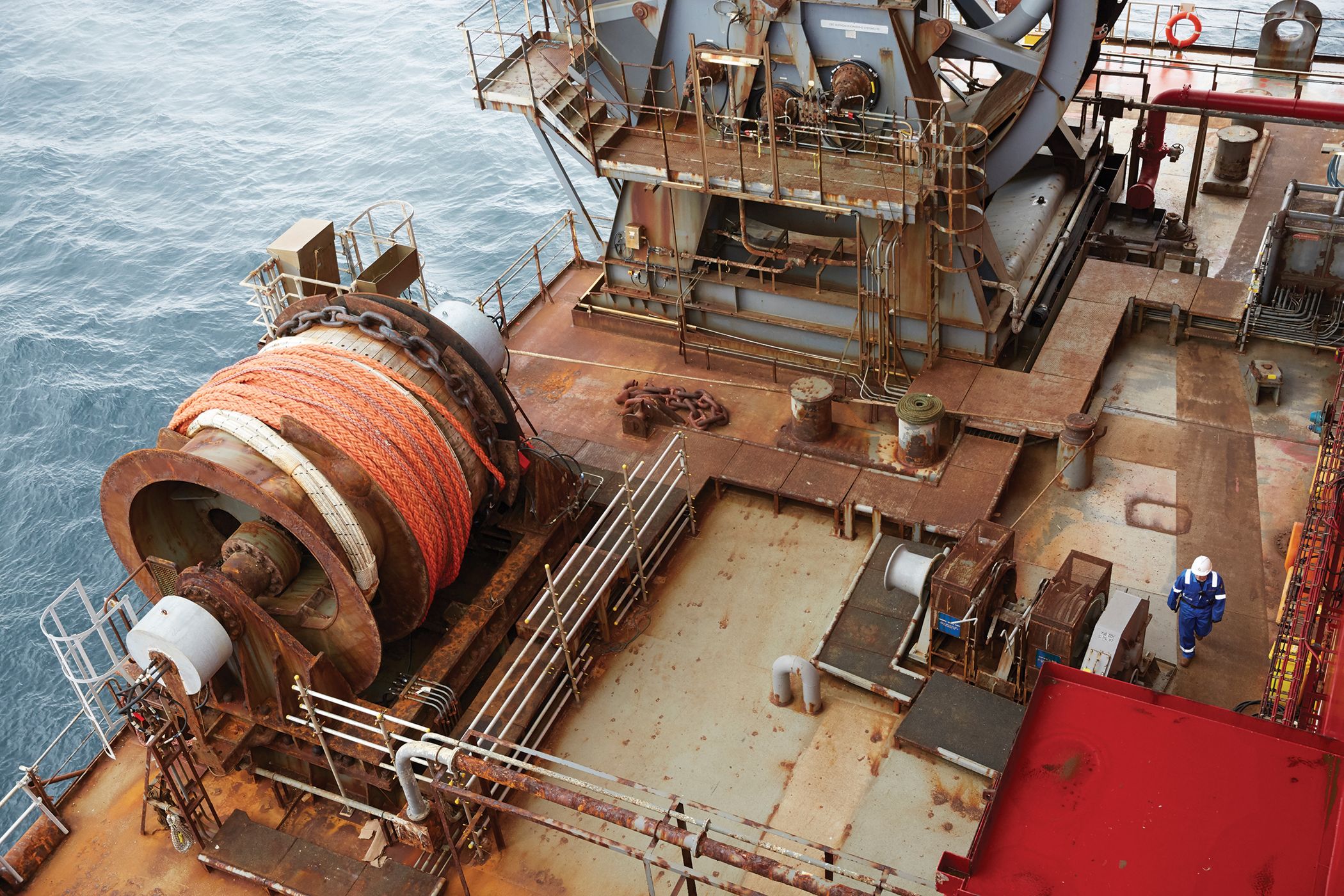DIGITISING PETROFAC
HOW DIGITAL TECHNOLOGY COULD HELP PETROFAC AND ITS CLIENTS TO WORK FASTER, SMARTER AND SAFER THAN EVER BEFORE
You may have noticed a new enthusiasm for digital technology taking hold in Petrofac. Right across the business, teams of people have been challenging conventional wisdom and asking tough questions. Meanwhile, the company has made some significant new senior appointments, bringing in proven technology leaders. It’s all part of our new strategic programme to reimagine the way the company operates – and understand how digital technology could help Petrofac and its clients.
”Undignihil moluptae plabo atiunt lanis quidel iuscius ciisque.”

HOW WE WORK
WORDS PETER HALLIDAY
IMAGES SHAILESH CHAVDA
PUBLISHED DECEMBER 2018

WHAT CAN DIGITAL TECHNOLOGY DO FOR A COMPANY LIKE PETROFAC?
Digital technology has disrupted many different sectors. The music business, the TV business, the banking business, and the publishing business have all been totally transformed by technology.
But, then again, these are all information businesses. They deal with bits and bytes, like account data in the case of a bank, or streaming video in the case of a broadcaster.
Surely, Petrofac is different? It deals with BIG physical things, made of steel and concrete. Technologies like artificial intelligence and the blockchain will never make that much difference to engineering and oilfield services, will they?
If you ever ask that question to anyone in the technology leadership team, brace yourself for a robust response.
Chief Digital Officer Fady Sleiman offers a great example of how technology can benefit an operations and maintenance business. “When I was at GE, we developed a new predictive analytics system for the maintenance of jet engines. If you avoid the need to take an engine out of service, you save an airline US$1 million a day. We implemented the system at Emirates, who soon deployed it across 190 aircraft, and it’s now being used by 45 airlines worldwide. Like oil and gas, aviation is a high-cost, high-risk, high-stakes sector. Any technology-enabled improvements have a huge bottom-line impact.”
Elie Lahoud, Group MD, Engineering and Construction, offers an alternative perspective. “For me, with a background in project execution, it’s all about consistency. If technology enables us to work in the same disciplined way and apply the same deep knowledge across every single project, we become a safer and more efficient machine.”
So, you begin to see the immediate opportunities for Petrofac. Technology can enable the company to work faster, smarter, more predictably and more safely. It can also be used to create new services for clients. But, in time, technology could bring bigger disruptions – not just incremental improvements.
Think about Uber, for example, which quickly became the world’s biggest land transportation company. It’s not in the information business. Instead, it uses technology to choreograph the movement of thousands of taxis through busy city streets and deliver a better experience to consumers. So, it’s worth thinking about the oil and gas facilities of the future. They could be designed by artificial intelligence, built by 3D printers, monitored by machine learning, and run by robots. If it were to do nothing differently, Petrofac could fall victim to any of these changes. But, by digitising its business, it is well positioned to benefit from whatever the future may bring.
SEEING INTO THE FUTURE WITH PETROLYTICS
Using artificial intelligence (AI) and machine learning (ML) to optimise performance, predict problems, and avoid crises.
Steve Johnson, Vice President of Digital at EPS West, says: “In the EPS business, the money we’re paid reflects the targets we hit. If we get a better performance, we get more money, not to mention a happier client. “The key here is to get the servicing and maintenance programmes exactly right, so you’re not wasting money replacing things that are in good condition, and neither are you caught out by unexpected failures. With one of its very first digital pilot programmes, EPS is aiming to resolve this dilemma with the help of artificial intelligence (AI) and machine learning (ML) algorithms.
By hooking up to the sensors that are already installed in all of an asset’s key components, a huge amount of data can be harvested. And the job of the algorithms is to find tell-tale patterns, so that performance is forecasted, production is optimised, and potential failures are predicted. The conclusions are fed through to a digital dashboard, enabling the operator to dig down for more information and make a judgement call about when and how to intervene.
It’s all very well in theory. But how do battle-hardened asset managers react to the technology? “The system is now being deployed in the North Sea on FPF1, and the feedback has been incredibly positive. Everyone gets it, everyone sees the benefits, and everyone understands how it could transform our business,” says Steve.
As well as improving the performance on existing operations and maintenance contracts, the systems could open up new markets for Petrofac. For example, Petrolytics could be sold as a standalone service, irrespective of who is actually responsible for actually managing or maintaining an asset.
For now, Petrolytics is still in pilot mode. But, given the level of enthusiasm, it seems destined to be rolled-out more widely. As John Pearson says, “I know it will work, I know it will add a few percentage points to the uptime performance of any asset, and I know it will position us in a whole new light in the oil and gas market.”
BECOMING ALL-SEEING AND ALL-KNOWING
Omniscience is a useful word. It means the capacity to know everything, or to have unlimited understanding. And it would be a useful quality to apply in the Engineering and Construction business.
One of the big challenges in the world of engineering and construction is to maintain a comprehensive, real-time overview of everything that ever happens on every project.
Elie Lahoud says: “If a project director could always get a direct line-of-sight to all their materials, and equipment, and people, and documents, the outcome would be far more predictable. No more money wasted because the right components are not in the right place at the right time. “No more time wasted because the teams or the equipment are not where you expected them. No more abortive and out-of-sequence tasks. A lot of the complexity of a large project could be eliminated.”
But how, exactly, do you keep track of it all? How could you make the task more efficient? And what could be done to transfer all of the learnings from each task to the next, and each new facility to the next?
These are some of the questions that have been wrestled with in Petrofac’s digitisation programme.
And Biju Nambiar, HOD – Business Systems & Digital Transformation Programme Manager at Engineering and Construction has been coordinating the process.
Tracking and tracing every element
Five projects are now being piloted. One example is an initiative to introduce an integral Document Management system, bringing in automated change detection. Another is a platform for visualising and tracking project management, which provides a graphical view of project progress across every function.
Ultimately, the aim is to automatically track every tool, every vehicle, every component, and every worker, on every site. That way, you know where everyone and everything is at all times, which brings new efficiencies, and also improves safety.
Creating a digital doppelganger
This level of omniscience also brings another dividend. With every detail of every asset captured, you can also create a digital twin, which is identical in every way to its physical counterpart, and encompasses information relating to the specification and provenance of every component. This then provides an invaluable tool for subsequent operations and maintenance programmes.
Removing repetitive work-flows
There is also a big opportunity to cut down on highly repetitive work-flows. “By its nature, every oil and gas facility has a lot of similar components, but each one has subtle variations,” explains Biju. “In the past, we would painstakingly design them hand-over-hand, one-after-the-other. Now we are using replication technology, which takes a single design, and automatically generates a full set of technical drawings for every subsequent variation. It may sound simple, but it’s actually very complex.”

TAKING ALL OF PETROFAC OFFSHORE (AND VICE VERSA)
Using wearable technologies to connect remote, offshore workers with onshore operations.
“All too often, an offshore worker encounters an unexpected problem that they’re not equipped to solve alone,” says Steve Johnson, Vice President of Digital at EPS West. “For example, they might face a fault that requires a specialist opinion. So, all they can do is to log the issue, and send a subject matter expert to deal with it.”
The new Connected Worker system promises a solution. Using the latest headset technology, combining heads-up displays, voice-based interaction, and head-mounted cameras, it becomes possible for the people working on platforms to have a direct technical link to the full resources of the onshore teams – while the onshore teams get a direct line-of-sight to the platform. Then, when they do encounter an issue, they can easily call-up all of the related documentation. Or, if they need expert guidance, they can talk directly to the expert. The camera shows what they are doing. Their work can be signed-off, there and then. And this approach promises to bring a whole new level of productivity.
John Pearson offers up a useful analogy: “A maintenance visit to an asset is the Petrofac equivalent of a pit stop in Formula One racing. You’ve got a limited amount of time to do a lot of work to an inordinately high standard. The difference is that, in Formula One, they’ve been applying more and more innovation and technology to the pit stop. So, what used to take a painfully long time can now be achieved in less than two seconds. Think about what could be achieved if we made similar gains in our own business.”
As with Petrolytics, the Connected Worker programme is still in pilot mode. But, given the level of enthusiasm among the EPS teams, its roll-out is beginning to look a lot like an inevitability.

RE-FRAMING THE DIALOGUE
With the new emphasis on digitisation, Petrofac is beginning to change the way it presents itself to the market, and the way it interacts with clients.
For example, a new exhibition stand has been developed to use at all of the big oil and gas events, which emphasises the Group’s emerging technological credentials. Similarly, Petrofac spokespeople are speaking about digital dividends at several industry conferences.
Another new development is the creation of an innovation zone, which opened in Aberdeen in December. This provides an opportunity for clients to experience new technological solutions first-hand and discuss the ways that they could be deployed in their own assets.
By engaging with clients in this way, the nature of the interaction changes. Attention is focused on the potential value of digital technology, and Petrofac positions itself as a pioneer in the field.

